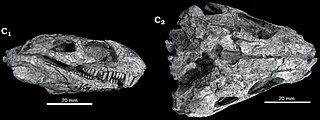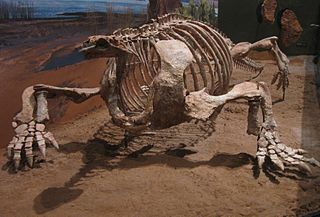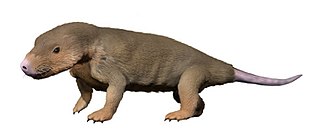
Synapsids are one of the two major clades of vertebrate animals in the group Amniota, the other being the sauropsids, which include reptiles and birds. The synapsids were once the dominant land animals in the late Paleozoic and early Mesozoic, but the only extant group that survived into the Cenozoic are the mammals. Unlike other amniotes, synapsids have a single temporal fenestra, an opening low in the skull roof behind each eye orbit, leaving a bony arch beneath each; this accounts for their name. The distinctive temporal fenestra developed about 318 million years ago during the Late Carboniferous period, when synapsids and sauropsids diverged, but was subsequently merged with the orbit in early mammals.

Sphenacodontia is a stem-based clade of derived synapsids. It was defined by Amson and Laurin (2011) as "the largest clade that includes Haptodus baylei, Haptodus garnettensis and Sphenacodon ferox, but not Edaphosaurus pogonias". They first appear during the Late Pennsylvanian epoch. From the end of the Carboniferous to the end of the Permian, most of them remained large, with only some secondarily becoming small in size.

Petrolacosaurus is an extinct genus of diapsid reptile from the late Carboniferous period. It was a small, 40-centimetre (16 in) long reptile, and one of the earliest known reptile with two temporal fenestrae. This means that it was at the base of Diapsida, the largest and most successful radiation of reptiles that would eventually include all modern reptile groups, as well as dinosaurs and other famous extinct reptiles such as plesiosaurs, ichthyosaurs, and pterosaurs. However, Petrolacosaurus itself was part of Araeoscelida, a short-lived early branch of the diapsid family tree which went extinct in the mid-Permian.
Varanopidae is an extinct family of amniotes that resembled monitor lizards and may have filled a similar niche, hence the name. Typically, they are considered synapsids that evolved from an Archaeothyris-like synapsid in the Late Carboniferous. However, some recent studies have recovered them being taxonomically closer to diapsid reptiles. A varanopid from the latest Middle Permian Pristerognathus Assemblage Zone is the youngest known varanopid and the last member of the "pelycosaur" group of synapsids.

Tetraceratops insignis is an extinct synapsid from the Early Permian that was formerly considered the earliest known representative of Therapsida, a group that includes mammals and their close extinct relatives. It is known from a single 90-millimetre-long (3.5 in) skull, discovered in Texas in 1908. According to a 2020 study, it should be classified as a primitive non-therapsid sphenacodont rather than a genuine basal therapsid.

Mycterosaurus is an extinct genus of synapsids belonging to the family Varanopidae. It is classified in the varanopid subfamily Mycterosaurinae. Mycterosaurus is the most primitive member of its family, existing from 290.1 to 272.5 MYA, known to Texas and Oklahoma. It lacks some features that its advanced relatives have.

Eothyris is a genus of extinct synapsid in the family Eothyrididae from the early Permian. It was a carnivorous insectivorous animal, closely related to Oedaleops. Only the skull of Eothyris, first described in 1937, is known. It had a 6-centimetre-long (2.4-inch) skull, and its total estimated length was 30 centimetres. Eothyris is one of the most primitive synapsids known and is probably very similar to the common ancestor of all synapsids in many respects. The only known specimen of Eothyris was collected from the Artinskian-lower.

Cotylorhynchus is an extinct genus of herbivorous caseid synapsids that lived during the late Lower Permian (Kungurian) and possibly the early Middle Permian (Roadian) in what is now Texas and Oklahoma in the United States. The large number of specimens found make it the best-known caseid. Like all large herbivorous caseids, Cotylorhynchus had a short snout sloping forward and very large external nares. The head was very small compared to the size of the body. The latter was massive, barrel-shaped, and ended with a long tail. The limbs were short and robust. The hands and feet had short, broad fingers with powerful claws. The barrel-shaped body must have housed large intestines, suggesting that the animal had to feed on a large quantity of plants of low nutritional value. Caseids are generally considered to be terrestrial, though a semi-aquatic lifestyle has been proposed by some authors. The genus Cotylorhynchus is represented by three species, the largest of which could reach more than 6 m in length. However, a study published in 2022 suggests that the genus may be paraphyletic, with two of the three species possibly belonging to separate genera.
Angelosaurus is an extinct genus of herbivorous caseid synapsids that lived during the late Lower Permian (Kungurian) and early Middle Permian (Roadian) in what is now Texas and Oklahoma in the United States. Like other herbivorous caseids, it had a small head, large barrel-shaped body, long tail, and massive limbs. Angelosaurus differs from other caseids by the extreme massiveness of its bones, particularly those of the limbs, which show a strong development of ridges, processes, and rugosities for the attachment of muscles and tendons. Relative to its body size, the limbs of Angelosaurus were shorter and wider than those of other caseids. The ungual phalanges looked more like hooves than claws. The few known cranial elements show that the skull was short and more robust than that of the other representatives of the group. Angelosaurus is also distinguished by its bulbous teeth with shorter and wider crowns than those of other caseids. Their morphology and the high rate of wear they exhibit suggests a diet quite different from that of other large herbivorous caseids, and must have been based on particularly tough plants. A study published in 2022 suggests that the genus may be paraphyletic, with Angelosaurus possibly only represented by its type species A. dolani.

Ennatosaurus is an extinct genus of caseid synapsid that lived during the Middle Permian in northern European Russia. The genus is only represented by its type species, Ennatosaurus tecton, which was named in 1956 by Ivan Antonovich Efremov. The species is known from at least six skulls associated with their lower jaws, as well as from the postcranial bones of several juvenile individuals. Ennatosaurus has the typical caseid skull with a short snout tilted forward and very large external nares. However, it differs from other derived caseids by its postcranial skeleton with smaller proportions compared to the size of the skull. As with other advanced caseids, the teeth of Ennatosaurus were well suited for slicing and cutting vegetation. The presence of a highly developed hyoid apparatus indicates the presence of a massive and mobile tongue, which had to work in collaboration with the palatal teeth during swallowing. With a late Roadian - early Wordian age, Ennatosaurus is one of the last known caseids.

Limnoscelis was a genus of large diadectomorph tetrapods from the Late Carboniferous of western North America. It includes two species: the type species Limnoscelis paludis from New Mexico, and Limnoscelis dynatis from Colorado, both of which are thought to have lived concurrently. No specimens of Limnoscelis are known from outside of North America. Limnoscelis was carnivorous, and likely semiaquatic, though it may have spent a significant portion of its life on land. Limnoscelis had a combination of derived amphibian and primitive reptilian features, and its placement relative to Amniota has significant implications regarding the origins of the first amniotes.

Colobomycter is an extinct genus of lanthanosuchoid parareptile known from the Early Permian of Oklahoma.

Aerosaurus is an extinct genus within Varanopidae, a family of non-mammalian synapsids. It lived between 252-299 million years ago during the Early Permian in North America. The name comes from Latin aes (aeris) “copper” and Greek sauros “lizard,” for El Cobre Canyon in northern New Mexico, where the type fossil was found and the site of former copper mines. Aerosaurus was a small to medium-bodied carnivorous synapsid characterized by its recurved teeth, triangular lateral temporal fenestra, and extended teeth row. Two species are recognized: A. greenleeorum (1937) and A. wellesi (1981).

Acleistorhinus (ah-kles-toe-RYE-nuss) is an extinct genus of parareptile known from the Early Permian of Oklahoma. It is notable for being the earliest known anapsid reptile yet discovered. The morphology of the lower temporal fenestra of the skull of Acleistorhinus bears a superficial resemblance to that seen in early synapsids, a result of convergent evolution. Only a single species, A. pteroticus, is known, and it is classified in the Family Acleistorhinidae, along with Colobomycter.

Heleosaurus scholtzi is an extinct species of basal synapsids, known as pelycosaurs, in the family of Varanopidae during the middle Permian. At first H. scholtzi was mistakenly classified as a diapsid. Members of this family were carnivorous and had dermal armor, and somewhat resembled monitor lizards. This family was the most geologically long lived, widespread, and diverse group of early amniotes. To date only two fossils have been found in the rocks of South Africa. One of these fossils is an aggregation of five individuals.

Microleter is an extinct genus of basal procolophonomorph parareptiles which lived in Oklahoma during the Early Permian period. The type and only known species is Microleter mckinzieorum. Microleter is one of several parareptile taxa described from the Richards Spur fissure fills, and can be characterized from its high tooth count, lacrimal/narial contact, short postfrontal, and slit-like temporal emargination edged by the postorbital, jugal, squamosal, and quadratojugal. Contrary to Australothyris, which had a similar phylogenetic position as a basal procolophonomorph, Microleter suggests that early parareptile evolution occurred in Laurasia and that multiple lineages developed openings or emarginations in the temporal region.
Huskerpeton is an extinct genus of recumbirostran from the Early Permian period. They belong to the order Microsauria, which was established in 1863 by Dawson, and was quickly expanded to include many different small taxa. They lived in what is now Nebraska and Kansas. The holotype of Huskerpeton was uncovered at the Eskridge formation in Nebraska, which is part of how it got its name.

Anomocephaloidea is a clade of basal anomodont therapsids related to the dicynodonts known from what is now South Africa and Brazil during the Middle Permian. It includes only two species, Anomocephalus africanus from the Karoo Basin of South Africa and Tiarajudens eccentricus from the Paraná Basin of Brazil. Anomocephaloidea was named in 2011 with the discovery of Tiarajudens, although Anomocephalus itself has been known since 1999.

Abdalodon is an extinct genus of late Permian cynodonts, known by its only species A. diastematicus.Abdalodon together with the genus Charassognathus, form the clade Charassognathidae. This clade represents the earliest known cynodonts, and is the first known radiation of Permian cynodonts.

Kenomagnathus is a genus of synapsid belonging to the Sphenacodontia, which lived during the Pennsylvanian subperiod of the Carboniferous in what is now Garnett, Kansas, United States. It contains one species, Kenomagnathus scottae, based on a specimen consisting of the maxilla and lacrimal bones of the skull, which was catalogued as ROM 43608 and originally classified as belonging to "Haptodus" garnettensis. Frederik Spindler named it as a new genus in 2020.

























